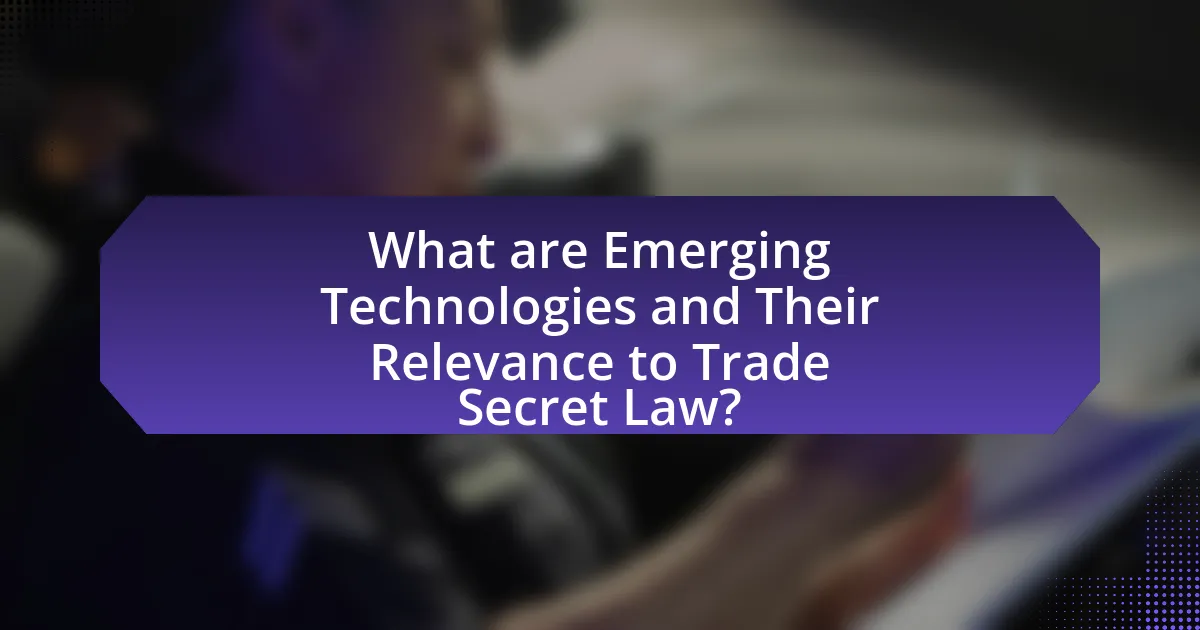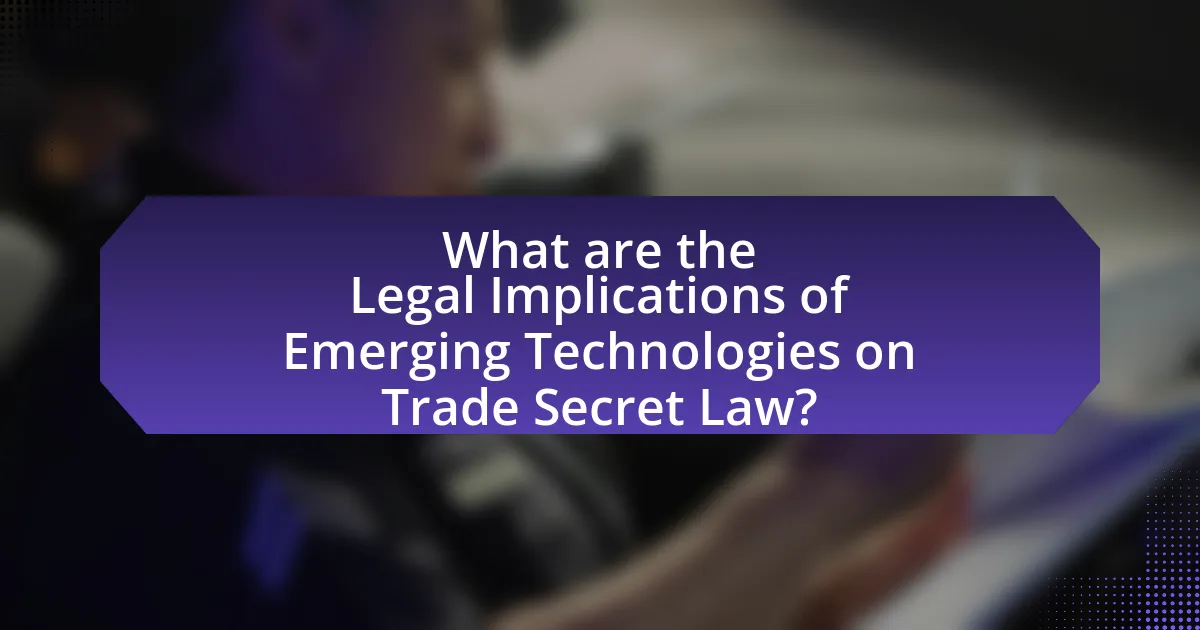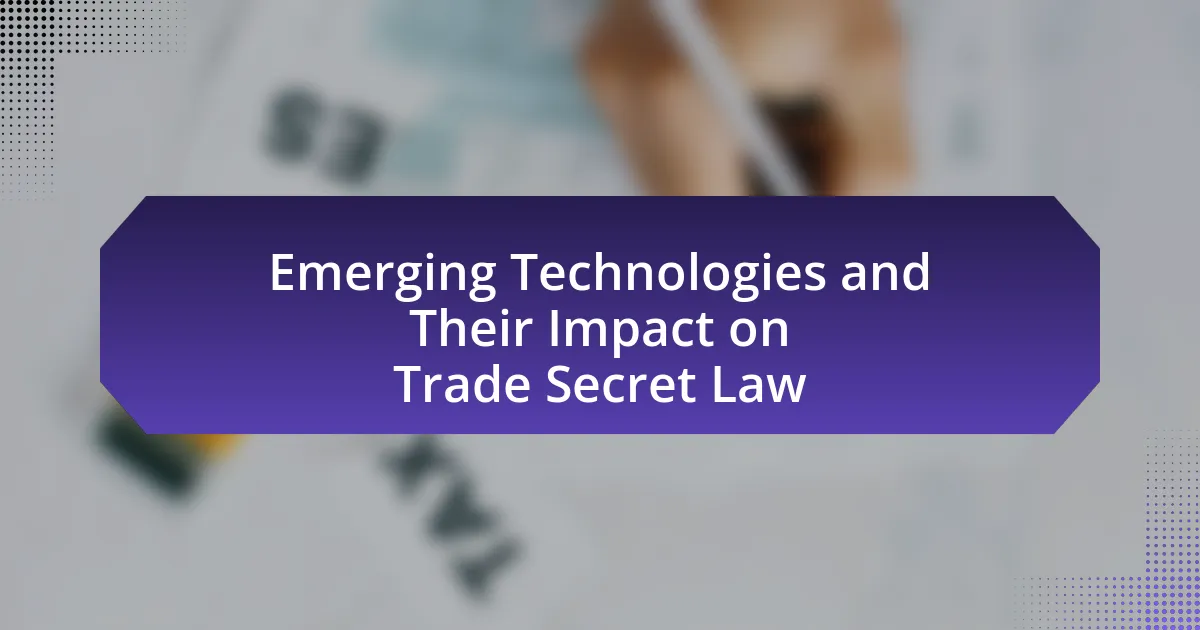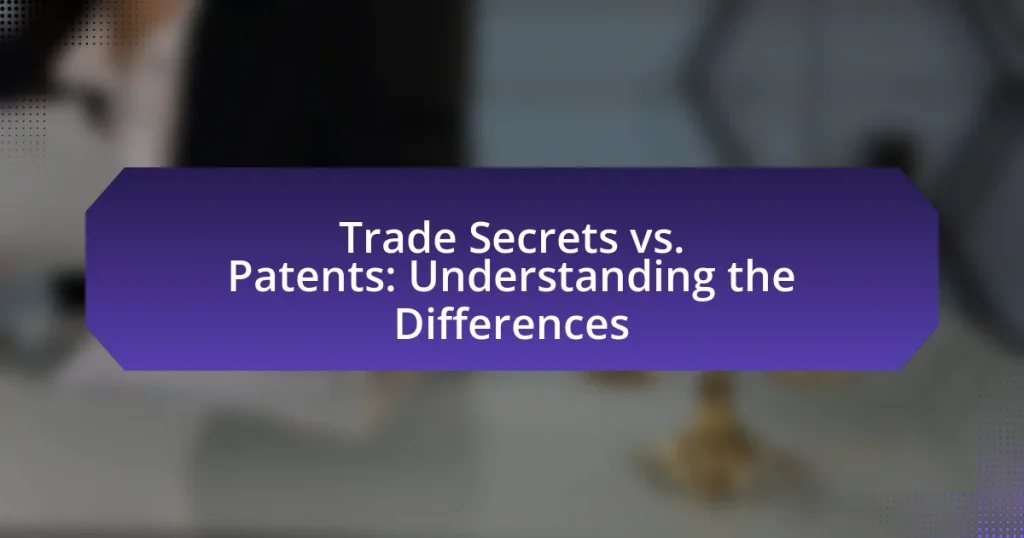Emerging technologies, including artificial intelligence, blockchain, and quantum computing, are significantly reshaping trade secret law by increasing the complexity of what constitutes confidential information and heightening the risks of misappropriation. This article examines how these advancements redefine trade secrets, the legal implications they pose, and the necessity for businesses to adapt their protection strategies. It highlights the importance of robust cybersecurity measures, employee training, and compliance with evolving legal frameworks to safeguard proprietary information in a rapidly changing digital landscape. Additionally, the article discusses the challenges courts face in applying existing laws to new technologies and the potential legislative changes required to address these issues effectively.

What are Emerging Technologies and Their Relevance to Trade Secret Law?
Emerging technologies refer to innovative advancements such as artificial intelligence, blockchain, and quantum computing that are rapidly evolving and reshaping various industries. Their relevance to trade secret law lies in the increased risk of misappropriation and the need for robust protection mechanisms, as these technologies often involve sensitive proprietary information that companies rely on for competitive advantage. For instance, the rise of AI has led to concerns about the unauthorized use of algorithms and data, prompting legal frameworks to adapt and address these challenges effectively.
How do emerging technologies redefine the concept of trade secrets?
Emerging technologies redefine the concept of trade secrets by increasing the complexity and scope of what can be considered confidential information. Technologies such as artificial intelligence, blockchain, and cloud computing enable the creation, storage, and sharing of sensitive data in ways that were previously unimaginable, thus expanding the definition of trade secrets beyond traditional formulas or processes to include algorithms, customer data, and proprietary software. For instance, the rise of AI has led to the development of machine learning models that can be classified as trade secrets due to their unique training data and methodologies. Additionally, the use of blockchain technology enhances the security of trade secrets by providing immutable records of access and modifications, thereby reinforcing the legal protections surrounding them. These advancements necessitate a reevaluation of existing trade secret laws to ensure they adequately protect the evolving nature of confidential business information in a digital landscape.
What types of emerging technologies are influencing trade secret law?
Artificial intelligence, blockchain technology, and the Internet of Things (IoT) are the primary emerging technologies influencing trade secret law. Artificial intelligence enhances data analysis and decision-making, leading to new methods of protecting proprietary information. Blockchain technology offers secure and transparent record-keeping, which can help in proving ownership and protecting trade secrets from unauthorized access. The Internet of Things connects devices and systems, increasing the risk of trade secret theft through vulnerabilities in interconnected networks. These technologies necessitate updates to legal frameworks to address new challenges in safeguarding confidential business information.
How do these technologies change the way businesses protect their trade secrets?
Emerging technologies, such as artificial intelligence, blockchain, and advanced encryption, significantly enhance the methods businesses use to protect their trade secrets. These technologies enable more robust data security measures, allowing companies to safeguard sensitive information through automated monitoring, secure transactions, and improved access controls. For instance, blockchain technology provides an immutable ledger that can track the access and modification of trade secrets, ensuring that any unauthorized changes are easily identifiable. Additionally, AI-driven analytics can detect anomalies in data access patterns, alerting businesses to potential breaches in real-time. These advancements not only strengthen the protection of trade secrets but also help companies comply with evolving legal standards regarding data privacy and security.
Why is understanding the impact of emerging technologies on trade secret law important?
Understanding the impact of emerging technologies on trade secret law is important because these technologies can significantly alter how trade secrets are created, protected, and enforced. For instance, advancements in artificial intelligence and data analytics can lead to new methods of information sharing and collaboration, which may inadvertently expose trade secrets to unauthorized access. Additionally, the rise of cloud computing and remote work environments increases the risk of data breaches, necessitating a reevaluation of existing legal frameworks to ensure adequate protection. The Uniform Trade Secrets Act and the Defend Trade Secrets Act of 2016 highlight the need for businesses to adapt their strategies in response to these technological changes, as failure to do so could result in loss of competitive advantage and legal vulnerabilities.
What risks do businesses face without adapting to these changes?
Businesses face significant risks without adapting to changes in emerging technologies, including loss of competitive advantage, increased vulnerability to cyber threats, and potential legal liabilities. Failure to integrate new technologies can result in outdated operational practices, making it difficult to compete with more agile competitors who leverage advancements for efficiency and innovation. For instance, a study by McKinsey & Company found that companies that adopt digital technologies can increase their productivity by up to 20%. Additionally, without adapting, businesses may expose themselves to data breaches and intellectual property theft, as traditional security measures may not suffice against sophisticated cyberattacks. The legal landscape surrounding trade secrets is also evolving; companies that do not update their practices may inadvertently violate new regulations, leading to costly litigation and penalties.
How can companies leverage emerging technologies to enhance their trade secret protections?
Companies can leverage emerging technologies such as blockchain, artificial intelligence, and advanced encryption to enhance their trade secret protections. Blockchain technology provides a secure and immutable ledger for tracking access and modifications to sensitive information, ensuring that any unauthorized changes can be easily identified. Artificial intelligence can analyze patterns of access and usage, helping to detect potential breaches or insider threats in real-time. Advanced encryption methods protect data both at rest and in transit, making it significantly more difficult for unauthorized parties to access trade secrets. According to a 2021 report by the Ponemon Institute, organizations that implemented advanced encryption saw a 50% reduction in data breaches, underscoring the effectiveness of these technologies in safeguarding sensitive information.

What are the Legal Implications of Emerging Technologies on Trade Secret Law?
Emerging technologies significantly impact trade secret law by altering how information is protected and shared. The rise of digital platforms and data analytics has increased the risk of trade secret misappropriation, as sensitive information can be more easily accessed and disseminated. For instance, the use of artificial intelligence in data processing can inadvertently expose trade secrets if not properly secured, leading to potential legal disputes under the Uniform Trade Secrets Act, which defines misappropriation and outlines protections. Additionally, the global nature of technology means that trade secret laws may vary across jurisdictions, complicating enforcement and compliance for businesses operating internationally. This complexity necessitates that companies adopt robust cybersecurity measures and legal strategies to safeguard their proprietary information in an evolving technological landscape.
How do current trade secret laws accommodate emerging technologies?
Current trade secret laws accommodate emerging technologies by providing legal frameworks that protect confidential business information, including algorithms, software code, and data analytics methods. These laws, such as the Uniform Trade Secrets Act and the Defend Trade Secrets Act in the United States, recognize the importance of safeguarding proprietary information in a digital landscape where technology evolves rapidly. For instance, the definition of trade secrets has been broadened to include digital formats and online data, ensuring that businesses can protect their innovations against misappropriation in the tech sector. Additionally, courts have increasingly upheld trade secret claims involving technological processes, reinforcing the legal protections available to companies in industries like software development and biotechnology.
What challenges do courts face in applying existing laws to new technologies?
Courts face significant challenges in applying existing laws to new technologies due to the rapid pace of technological advancement, which often outstrips the legislative process. This discrepancy creates gaps in legal frameworks, making it difficult for judges to interpret laws that were not designed with modern technologies in mind, such as artificial intelligence and blockchain. For instance, the Uniform Trade Secrets Act, which governs trade secret protection, may not adequately address issues arising from digital data sharing and cybersecurity threats, leading to inconsistent rulings. Additionally, the lack of established legal precedents for emerging technologies complicates judicial decision-making, as courts must navigate uncharted legal territory without clear guidelines.
How have recent legal cases shaped the understanding of trade secrets in the context of technology?
Recent legal cases have clarified the scope and protection of trade secrets in technology by establishing precedents that define what constitutes a trade secret and the extent of legal recourse for misappropriation. For instance, the case of Waymo v. Uber highlighted the importance of demonstrating reasonable efforts to maintain secrecy, reinforcing that companies must actively protect their proprietary information. Additionally, the ruling in the case of Epic Games v. Apple emphasized the need for clear definitions of trade secrets in the context of software and digital platforms, influencing how technology firms approach confidentiality and competitive advantage. These cases collectively shape the legal landscape by providing clearer guidelines on the protection of trade secrets, particularly in rapidly evolving technological environments.
What are the potential changes to trade secret law due to technological advancements?
Technological advancements are likely to lead to significant changes in trade secret law, particularly in areas such as digital security, data protection, and the definition of what constitutes a trade secret. As businesses increasingly rely on digital platforms and cloud storage, the legal framework may evolve to address the challenges of protecting confidential information in a cyber environment. For instance, the rise of artificial intelligence and machine learning could necessitate clearer guidelines on the ownership and protection of algorithms and data sets, which are often considered trade secrets. Additionally, the implementation of stricter data privacy regulations, such as the General Data Protection Regulation (GDPR) in Europe, may influence how trade secrets are defined and protected, emphasizing the need for companies to adopt robust security measures to safeguard their proprietary information.
How might legislation evolve to address the challenges posed by emerging technologies?
Legislation may evolve to address the challenges posed by emerging technologies by incorporating adaptive regulatory frameworks that respond to rapid technological advancements. For instance, lawmakers could implement flexible guidelines that allow for real-time updates to regulations as new technologies, such as artificial intelligence and blockchain, emerge. This approach is supported by the increasing pace of innovation, which often outstrips existing legal frameworks, necessitating a more dynamic legislative process. Additionally, countries like the United States have seen initiatives such as the National Artificial Intelligence Initiative Act, which aims to promote AI research while ensuring ethical standards, illustrating a proactive legislative response to technological challenges.
What role do international trade agreements play in shaping trade secret protections?
International trade agreements significantly influence trade secret protections by establishing common standards and legal frameworks that member countries must adhere to. These agreements, such as the Agreement on Trade-Related Aspects of Intellectual Property Rights (TRIPS), mandate that countries implement effective measures to protect trade secrets, thereby harmonizing laws across borders. For instance, TRIPS requires member states to provide legal remedies against the misappropriation of trade secrets, which enhances the security of confidential business information in international markets. This alignment fosters a more predictable and secure environment for businesses operating globally, encouraging innovation and investment in emerging technologies.

How Can Businesses Adapt to the Impact of Emerging Technologies on Trade Secret Law?
Businesses can adapt to the impact of emerging technologies on trade secret law by implementing robust data protection strategies and regularly updating their compliance protocols. As technologies evolve, the risk of trade secret misappropriation increases, necessitating enhanced security measures such as encryption, access controls, and employee training on confidentiality. For instance, a 2020 report by the U.S. Chamber of Commerce highlighted that companies with comprehensive cybersecurity practices are 50% less likely to experience data breaches, underscoring the importance of proactive measures. Additionally, businesses should stay informed about legal developments and technological advancements to ensure their trade secret protections remain effective and compliant with current laws.
What best practices should companies implement to protect their trade secrets in a tech-driven environment?
Companies should implement robust cybersecurity measures, employee training, and legal safeguards to protect their trade secrets in a tech-driven environment. Cybersecurity measures, such as encryption and access controls, help prevent unauthorized access to sensitive information. Employee training on confidentiality and data protection ensures that staff understand the importance of safeguarding trade secrets. Legal safeguards, including non-disclosure agreements and intellectual property protections, provide a framework for enforcing trade secret rights. According to the 2021 Global Cybersecurity Outlook report by the World Economic Forum, 95% of cybersecurity breaches are due to human error, highlighting the necessity of comprehensive employee training.
How can businesses conduct risk assessments related to their trade secrets?
Businesses can conduct risk assessments related to their trade secrets by identifying, evaluating, and mitigating potential threats to their confidential information. This process begins with identifying the trade secrets that are critical to the business’s competitive advantage, followed by assessing vulnerabilities such as employee access, cybersecurity measures, and physical security protocols.
Next, businesses should evaluate the likelihood and potential impact of various risks, including insider threats, data breaches, and unauthorized disclosures. Implementing measures such as employee training, access controls, and regular audits can help mitigate these risks.
According to the 2020 Global Risk Management Survey by Aon, 69% of organizations reported that they had experienced a data breach, highlighting the importance of proactive risk assessments in protecting trade secrets.
What training and policies should be established to safeguard sensitive information?
To safeguard sensitive information, organizations should implement comprehensive training programs and robust policies focused on data protection. Training programs must educate employees on identifying sensitive information, understanding data privacy laws, and recognizing potential security threats, such as phishing attacks. Policies should include strict access controls, data encryption protocols, and incident response procedures to address breaches effectively. According to the Ponemon Institute’s 2021 Cost of a Data Breach Report, organizations with a formal security training program experienced significantly lower data breach costs, highlighting the importance of such initiatives.
What tools and technologies can assist in protecting trade secrets?
Encryption software is a primary tool that assists in protecting trade secrets by securing sensitive information through complex algorithms. This technology ensures that only authorized individuals can access confidential data, thereby reducing the risk of unauthorized disclosure. Additionally, access control systems, such as role-based access control (RBAC), limit data access to specific users based on their roles within an organization, further safeguarding trade secrets.
Data loss prevention (DLP) solutions monitor and control data transfers, preventing sensitive information from being shared outside the organization. Furthermore, secure collaboration platforms enable teams to work together while maintaining the confidentiality of trade secrets through features like secure file sharing and communication encryption.
According to a report by the Ponemon Institute, organizations that implement encryption and DLP technologies experience a 30% reduction in data breaches, highlighting the effectiveness of these tools in protecting trade secrets.
How can cybersecurity measures enhance trade secret protection?
Cybersecurity measures enhance trade secret protection by implementing robust defenses against unauthorized access and data breaches. These measures include encryption, access controls, and continuous monitoring, which collectively safeguard sensitive information from cyber threats. For instance, a study by the Ponemon Institute found that organizations with strong cybersecurity practices experienced 50% fewer data breaches compared to those with weaker defenses. This demonstrates that effective cybersecurity not only protects trade secrets but also reduces the risk of financial loss and reputational damage associated with breaches.
What role does employee education play in maintaining trade secret confidentiality?
Employee education is crucial in maintaining trade secret confidentiality as it equips employees with the knowledge and skills necessary to recognize, protect, and handle sensitive information appropriately. By providing training on the importance of trade secrets, companies can foster a culture of confidentiality, ensuring that employees understand the legal implications and potential consequences of unauthorized disclosure. Research indicates that organizations with comprehensive employee training programs experience fewer incidents of trade secret breaches, highlighting the effectiveness of education in safeguarding proprietary information.
What are the common pitfalls businesses face regarding trade secrets in the age of technology?
Businesses commonly face several pitfalls regarding trade secrets in the age of technology, including inadequate protection measures, employee turnover, and data breaches. Inadequate protection measures occur when businesses fail to implement robust security protocols, leaving sensitive information vulnerable to unauthorized access. Employee turnover poses a risk as departing employees may take trade secrets with them or inadvertently disclose them to competitors. Data breaches, often resulting from cyberattacks, can lead to the exposure of confidential information, undermining a company’s competitive advantage. According to the 2021 Cost of a Data Breach Report by IBM, the average cost of a data breach is $4.24 million, highlighting the financial impact of such vulnerabilities on businesses.
How can companies avoid unintentional disclosure of trade secrets?
Companies can avoid unintentional disclosure of trade secrets by implementing strict confidentiality protocols and employee training programs. Establishing clear policies regarding the handling of sensitive information ensures that employees understand the importance of safeguarding trade secrets. Regular training sessions can reinforce these policies and educate staff on potential risks associated with sharing proprietary information, especially in environments where emerging technologies are utilized. For instance, a study by the Association for Corporate Counsel found that organizations with comprehensive training programs experienced a 30% reduction in data breaches related to trade secrets. Additionally, employing technological solutions such as encryption and access controls can further protect sensitive information from unauthorized access or accidental sharing.
What strategies can mitigate the risk of trade secret theft in a digital landscape?
Implementing robust cybersecurity measures is essential to mitigate the risk of trade secret theft in a digital landscape. Organizations should employ encryption for sensitive data, ensuring that even if data is intercepted, it remains unreadable. Additionally, access controls must be enforced, limiting data access to only those employees who require it for their roles, thereby reducing the potential for internal theft. Regular employee training on data protection and the importance of trade secrets can further enhance awareness and compliance. According to the Ponemon Institute’s 2020 Cost of a Data Breach Report, organizations that deploy security automation and incident response plans can reduce the cost of a data breach by an average of $3 million, highlighting the financial benefits of proactive measures.



